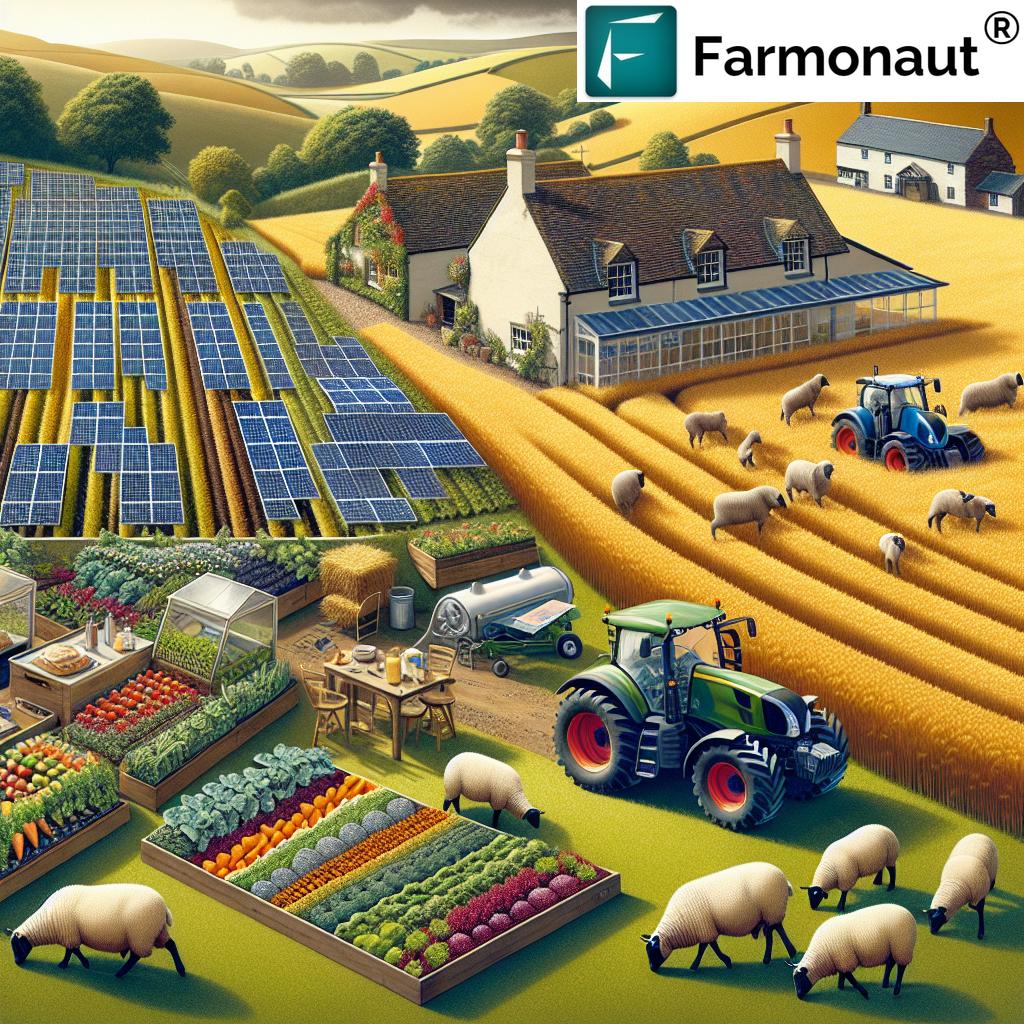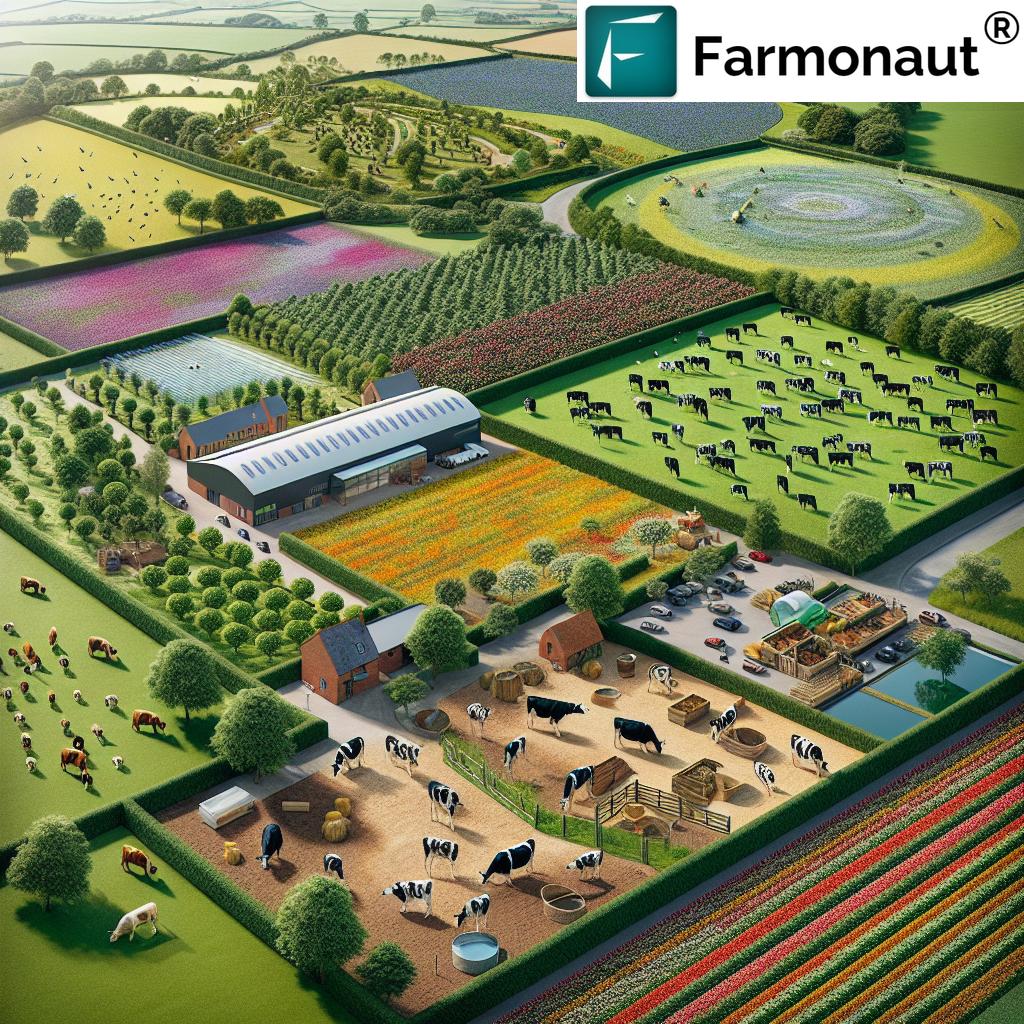UK Agricultural Land Trends: Maximizing Returns Through Farm Diversification Strategies
“UK agricultural land values have cooled, prompting 40% of farmers to diversify their income sources.”
Welcome to our comprehensive exploration of UK agricultural land trends and the innovative strategies farmers are employing to maximize returns on their investments. In this blog post, we’ll delve into the dynamic landscape of British agriculture, examining how farm diversification is reshaping the rural economy and transforming traditional farming practices.
As agricultural land values face cooling trends, savvy farmers and investors are turning to diversification strategies to optimize their assets and boost rural economic development. From renewable energy initiatives to organic produce, we’ll uncover the myriad ways in which rural property diversification is revolutionizing agricultural asset performance.
The Changing Face of UK Agriculture
The British agricultural sector is undergoing a significant transformation. Traditional farming methods are being complemented, and in some cases replaced, by innovative approaches that aim to maximize land value and boost returns. This shift is driven by several factors:
- Fluctuating agricultural land values
- Increasing pressure on farm profitability
- Growing demand for sustainable farming practices
- Evolving consumer preferences
- Technological advancements in agriculture
To navigate these changes successfully, farmers and landowners are increasingly turning to diversification strategies. Let’s explore some of the most promising approaches.
Farm Diversification Strategies
Farm diversification involves expanding beyond traditional agricultural activities to generate additional income streams. Here are some popular strategies that UK farmers are adopting:
1. Renewable Energy Projects
One of the most significant trends in farm diversification is the adoption of renewable energy projects. Many farmers are leveraging their land to generate clean energy through:
- Solar farms
- Wind turbines
- Biomass production
- Anaerobic digestion plants
These initiatives not only provide a steady income stream but also contribute to the UK’s renewable energy goals. For instance, a well-planned solar farm can generate substantial returns while utilizing otherwise unproductive land.
2. Organic Farming
The demand for organic produce has been steadily rising in the UK. Farmers who transition to organic methods can often command premium prices for their crops and livestock. While the conversion process requires initial investment and patience, the long-term benefits can be significant:
- Higher profit margins on produce
- Improved soil health and biodiversity
- Reduced reliance on costly chemical inputs
- Access to niche markets and loyal customer base
3. Agritourism
Agritourism is another promising diversification strategy that allows farmers to capitalize on the growing interest in rural experiences. This can include:
- Farm stays and glamping sites
- Pick-your-own fruit and vegetable experiences
- Farm tours and educational workshops
- On-farm restaurants and cafes
By opening their farms to visitors, landowners can create additional revenue streams while promoting agricultural awareness and rural tourism.
4. Value-Added Products
Processing raw agricultural products into value-added goods is another effective diversification strategy. This approach allows farmers to capture a larger share of the consumer pound. Examples include:
- Artisanal cheeses and dairy products
- Craft beer and cider production
- Jams, preserves, and condiments
- Farm-branded meat products
By developing unique, high-quality products, farmers can differentiate themselves in the market and build strong brand loyalty.
5. Contract Farming
Contract farming arrangements can provide a stable income stream for landowners while reducing their direct involvement in day-to-day farm operations. This model can be particularly attractive for those looking to maintain their agricultural assets without the full-time commitment of farming.

Now that we’ve outlined some key diversification strategies, let’s take a closer look at their potential returns and environmental impact:
| Diversification Strategy | Estimated Annual Return (%) | Initial Investment Range (£) | Environmental Impact |
|---|---|---|---|
| Renewable Energy Projects | 5-10% | 50,000 – 1,000,000+ | Positive |
| Organic Farming | 3-8% | 10,000 – 100,000 | Positive |
| Agritourism | 4-12% | 20,000 – 500,000 | Variable |
| Value-Added Products | 6-15% | 15,000 – 200,000 | Neutral |
| Contract Farming | 2-5% | Minimal | Variable |
As we can see from this table, each diversification strategy offers unique benefits and challenges. The choice of strategy will depend on factors such as available capital, land characteristics, and personal goals.
The Role of Technology in Farm Diversification
Technology plays a crucial role in enabling and enhancing farm diversification strategies. Advanced tools and platforms are helping farmers make data-driven decisions and optimize their operations. One such innovative solution is provided by Farmonaut, a pioneering agricultural technology company.
Farmonaut offers advanced, satellite-based farm management solutions via android, iOS, web/browser App, and API. These tools can significantly aid farmers in implementing and managing their diversification strategies effectively.
Here are some ways Farmonaut’s technology can support farm diversification:
- Real-time crop health monitoring for optimized organic farming
- AI-based advisory systems for informed decision-making
- Blockchain-based traceability for value-added products
- Resource management tools for efficient operations across diverse farm activities
To learn more about how Farmonaut can support your farm diversification efforts, check out their services:
Sustainable Farming Practices and Land Value Optimization
Sustainable farming practices are not just good for the environment; they can also significantly impact land values and long-term profitability. By implementing eco-friendly techniques, farmers can improve soil health, reduce input costs, and potentially access premium markets.
Some key sustainable farming practices that can optimize land value include:
- Conservation tillage
- Cover cropping
- Integrated pest management
- Precision agriculture techniques
- Agroforestry
These practices not only enhance the ecological value of the land but can also make properties more attractive to environmentally conscious buyers or tenants, potentially increasing their market value.
The Impact of Farm Diversification on Rural Economic Development
“Farm diversification strategies can increase rural property values by up to 25% through innovative land use.”
Farm diversification has a ripple effect on the broader rural economy. By creating new income streams and employment opportunities, diversified farms contribute to the vitality and resilience of rural communities. Some key benefits include:
- Job creation in non-traditional agricultural roles
- Increased local spending and economic activity
- Enhanced rural tourism and hospitality sectors
- Development of new skills and expertise in rural areas
- Improved infrastructure to support diversified activities
These factors collectively contribute to making rural areas more attractive for investment and development, potentially reversing trends of rural depopulation and economic decline.
Agricultural Investment Analysis: Key Considerations
For those considering investing in agricultural land or diversifying existing farm operations, a thorough investment analysis is crucial. Here are some key factors to consider:
- Current and projected land values in the target area
- Potential for various diversification strategies based on location and land characteristics
- Local and national regulations affecting agricultural activities and diversification
- Market demand for proposed products or services
- Initial capital requirements and expected return on investment
- Environmental impact and sustainability considerations
Investors should also consider the potential for leveraging technology to enhance returns. For instance, Farmonaut’s satellite-based solutions can provide valuable insights for land valuation and optimal use planning. Learn more about their API services at Farmonaut API and check out the API Developer Docs for detailed information.

Challenges and Risks in Farm Diversification
While farm diversification offers numerous benefits, it’s not without challenges. Farmers and investors should be aware of potential risks, including:
- High initial capital requirements for some diversification projects
- Regulatory hurdles and planning permissions
- Market volatility and changing consumer preferences
- Skills gap in managing new business ventures
- Potential conflicts with traditional farming activities
Mitigating these risks requires careful planning, market research, and often, professional advice. It’s also crucial to stay informed about the latest trends and technologies in agriculture and rural development.
Government Policies and Support for Farm Diversification
The UK government recognizes the importance of farm diversification in maintaining a vibrant and sustainable agricultural sector. Various policies and support mechanisms are in place to encourage farmers to explore diversification opportunities:
- Grants and funding programs for rural development projects
- Tax incentives for certain types of farm diversification
- Advisory services and training programs
- Simplified planning procedures for some agricultural developments
Farmers and investors should stay informed about these opportunities and how they can leverage government support in their diversification efforts.
The Future of UK Agriculture: Trends and Predictions
As we look to the future of UK agriculture, several trends are likely to shape the sector:
- Increased adoption of precision farming technologies
- Growing emphasis on sustainable and regenerative agriculture
- Continued diversification of farm income streams
- Greater integration of agriculture with other sectors (e.g., energy, tourism)
- Adaptation to climate change and emphasis on carbon sequestration
These trends suggest that the most successful farms of the future will likely be those that embrace diversification, sustainability, and technological innovation.
Conclusion: Embracing Change for a Thriving Agricultural Sector
The UK agricultural sector is at a crossroads, facing challenges but also unprecedented opportunities. Farm diversification strategies offer a pathway to maximizing returns on agricultural investments while contributing to rural economic development and sustainability.
By embracing innovative approaches, leveraging technology, and staying attuned to market trends, farmers and investors can position themselves for success in this dynamic environment. Whether it’s through renewable energy projects, agritourism, or value-added products, diversification can help create resilient, profitable, and sustainable farm businesses.
As we move forward, the integration of advanced technologies like those offered by Farmonaut will play an increasingly crucial role in optimizing farm operations and supporting diversification efforts. By combining traditional farming wisdom with cutting-edge solutions, the UK agricultural sector can build a prosperous and sustainable future.
FAQ Section
Q1: What are the main drivers behind farm diversification in the UK?
A1: The main drivers include fluctuating agricultural land values, pressure on farm profitability, demand for sustainable practices, changing consumer preferences, and technological advancements in agriculture.
Q2: How can technology support farm diversification efforts?
A2: Technology, such as Farmonaut’s satellite-based solutions, can provide real-time crop monitoring, AI-driven advisory systems, and resource management tools, helping farmers make informed decisions and optimize their diversified operations.
Q3: What are some popular farm diversification strategies in the UK?
A3: Popular strategies include renewable energy projects, organic farming, agritourism, value-added product development, and contract farming arrangements.
Q4: How does farm diversification impact rural communities?
A4: Farm diversification can create new job opportunities, increase local economic activity, enhance rural tourism, and contribute to the overall development and sustainability of rural areas.
Q5: What should investors consider when analyzing agricultural investment opportunities?
A5: Key considerations include current and projected land values, diversification potential, local regulations, market demand, capital requirements, expected returns, and environmental impact.






